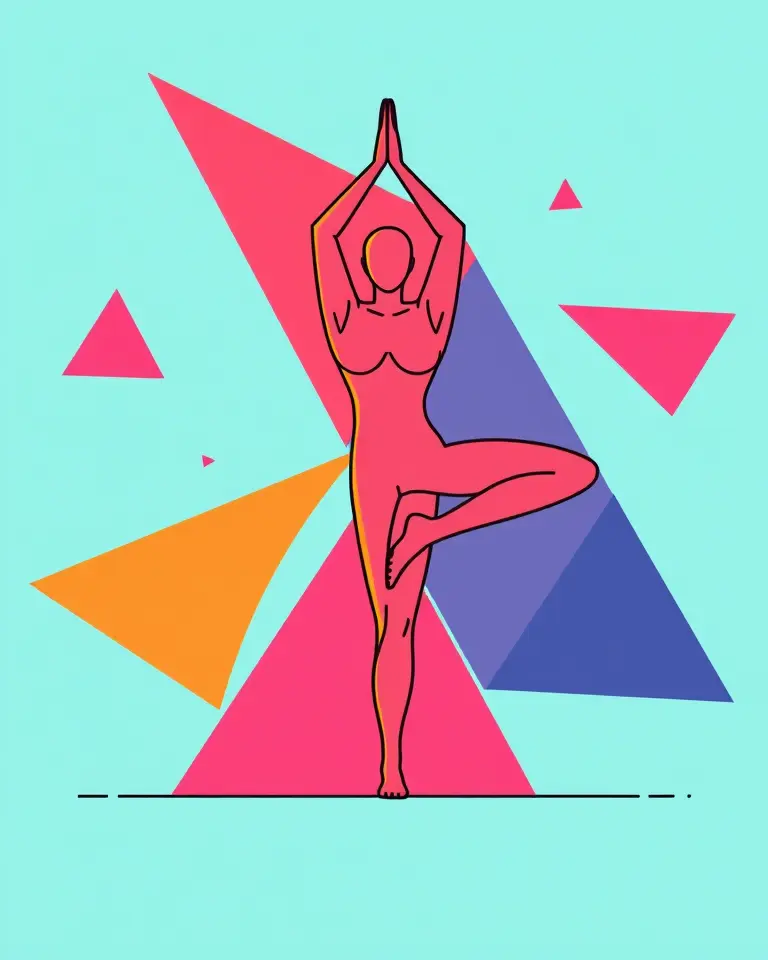The Triangle Pose, or Trikonasana in Sanskrit, is a foundational yoga asana that offers a wealth of benefits for both the body and mind. This standing posture, characterized by its triangular shape, is more than just a stretch; it’s a dynamic pose that builds strength, improves balance, and enhances overall well-being. Whether you’re a seasoned yogi or a beginner, incorporating Triangle Pose into your routine can bring significant positive changes.
What is Triangle Pose?
Triangle Pose is a standing yoga posture where the body forms a triangular shape with the floor, engaging various parts of the body as you lean your torso forward and extend your arms. Trikonasana is derived from the Sanskrit words “tri” (three) and “kona” (angle or corner). The pose is a combination of a lateral stretch, a twist, and a balance challenge. It is often practiced in many styles of yoga, including Hatha, Vinyasa, and Iyengar.
How to Do Triangle Pose
To perform the Triangle Pose, follow these steps:
- Start in a wide stance, with your feet about 3-4 feet apart, facing the long edge of your mat.
- Turn your right foot out 90 degrees and your left foot slightly inwards, about 45 degrees, aligning your heels.
- Engage your leg muscles, and keep your knees straight, without locking them.
- Extend your arms out to the sides, parallel to the floor, with your palms facing down.
- Inhale and as you exhale, reach your right arm forward as you bend from your hip joint towards your right leg, lengthening your torso.
- Place your right hand on your shin, ankle, or the floor outside your right foot. If you can’t reach the floor, use a block or rest your hand on your shin.
- Extend your left arm straight up towards the ceiling, in line with your shoulder.
- Turn your head to look up at your left hand, or if you have neck issues, look straight ahead or down at the floor.
- Keep your spine long and your chest open, and maintain a straight line from your shoulders to your hips.
- Hold the pose for 3-5 breaths, then inhale to come back up. Repeat on the other side.
9 Compelling Reasons to Include Triangle Pose in Your Routine
Here are nine reasons why you should consider incorporating Triangle Pose into your exercise routine:
1. Improves Balance and Stability
Triangle Pose is an excellent way to improve balance and stability. The pose requires a combination of a wide stance and a deep spinal twist, which engages your core muscles and helps you develop better body awareness. This translates to better balance both on and off the mat.
2. Strengthens Various Body Parts
This pose works several muscles in your body, contributing to overall strength. It strengthens the ankles, feet, legs, and inner thighs, promoting lower body stability. The core muscles, including the obliques and abdominals, are also engaged, improving core strength. The pose also strengthens the back, chest, and shoulders, making it a full-body workout. The quadriceps contract as you straighten your knees, while the hamstrings lengthen. The glutes and hip flexors work together to stabilize the pelvis.
3. Stretches Multiple Areas of the Body
Triangle Pose stretches the hamstrings, groins, and hips, increasing overall flexibility. It also opens the chest and shoulders, promoting better posture and relieving tension. The spine also benefits from the lateral stretch, from the lumbar to cervical areas, increasing its flexibility and mobility. The deep psoas, quadratus lumborum, and oblique muscles also lengthen in this pose.
4. Opens Hips and Shoulders
This posture is a great hip and heart opener, helping to release tension and improve mobility in these areas. The rotation of the torso and the extension of the arms work together to open up the shoulders and chest, which can help counteract the effects of prolonged sitting.
5. Energizes and Reduces Stress
Triangle Pose is an invigorating posture that can help increase energy levels and reduce stress. The deep stretches and the focus required in the pose can help calm the mind and release tension, promoting a sense of overall well-being.
6. Enhances Digestion
The twisting action of this pose can help stimulate the abdominal organs, which can enhance digestion and alleviate issues such as bloating. This makes it a great pose to include in your routine, especially if you have digestive issues. It also helps in releasing gastritis.
7. Improves Blood Circulation
Regular practice of Triangle Pose can improve blood circulation throughout the body. The pose stretches various muscles and increases the flow of blood to these areas, promoting better overall health.
8. Increases Lung Capacity
The opening of the chest and shoulders in this pose can help increase lung capacity. This is particularly beneficial for people with respiratory issues. The deep breaths taken during the pose can further help to oxygenate the body.
9. Promotes Mental Focus
The focus needed to maintain balance and alignment in the Triangle Pose helps improve mental focus and concentration. It can be a meditative experience that encourages mindfulness and presence.
Common Mistakes to Avoid
While Triangle Pose offers numerous benefits, it’s important to perform the pose correctly to avoid injury. Here are some common mistakes to watch out for:
- Rounding the back: Avoid rounding your back to reach your hand to the floor. Instead, maintain a long spine and use a block or rest your hand on your shin if needed.
- Dumping weight into the front hand: Avoid putting too much weight on your front hand. Engage your core and legs to keep your body stable.
- Bending the front knee: Keep your front leg straight without locking the knee.
- Taking too short or too long of a stance: Position your feet about three to four feet apart for optimal stability.
- Over-expanding your hips: Keep your hips aligned and avoid pushing them out too far.
- Tilting the head incorrectly: Position your head to keep your neck in line with your spine. Look up, straight ahead, or down if you have neck problems.
- Collapsing the core: Engage your core muscles throughout the pose to support your torso.
- Incorrect Alignment of the Feet and Knees: Ensure the front foot has toes facing forward and the back foot is slightly inward, as if an imaginary line could be drawn from the right heel to the center of the left foot, and the knees are aligned with the feet.
- Arching the back: Make sure to keep the spine elongated and straight, maintaining a straight line from the shoulders to the hips, avoiding arching.
Modifications and Variations
To make Triangle Pose more accessible or to deepen the stretch, here are some modifications and variations you can try:
Modifications
- Use a block: If you can’t reach the floor, place your hand on a yoga block for support.
- Hand on shin: If you can’t reach the floor or the block, lightly place your hand on your shin or thigh.
- Look down: If you experience neck strain, look towards the floor.
- Wall support: Use a wall for stability by placing your back or heel against it.
- Bent knee: If you have tight hamstrings, bend your front knee slightly.
- Reduce stance: Reduce the distance between your feet to decrease the intensity.
Variations
- Revolved Triangle Pose (Parivrtta Trikonasana): In this variation, instead of reaching your bottom arm towards the floor, twist your torso and reach your top arm down to the opposite foot. This variation provides a deeper stretch to the spine and improves digestion.
- Bound Triangle Pose (Baddha Trikonasana): In this advanced variation, bind your arms behind your back, which enhances shoulder flexibility and strength.
- Triangle Pose with Top Arm Extended Forward: From the full Triangle Pose, drop your top arm over your ear and reach your hand forward. This will intensify the stretch along your hamstrings, inner thighs, and the top side of your torso.
- Triangle Pose With a Chair: Place a chair in front of you, and instead of placing your hand on your shin, floor or a block, use the chair to support your hand.
- Triangle Pose with Props: There are several Triangle Pose variations using props like blocks and straps to further open up the pose, and make it more accessible.
- Triangle Pose Prep Arms Up: Instead of extending one arm to the floor and the other to the sky, reach both arms upwards, shoulder distance apart, while maintaining the rest of the pose.
- Triangle Pose Variation Hand on Shin: Instead of reaching for the floor, rest the hand on the shin while maintaining the rest of the pose.
- Triangle Pose Variation Bent Knee: Slightly bend the front knee while maintaining the rest of the pose.
Contraindications
While Triangle Pose is generally safe, certain individuals should avoid or modify the pose:
- Neck, knee, shoulder, or ankle injuries: Individuals with these injuries should avoid the pose or practice with modifications.
- Recent surgery: Avoid the pose if you have had recent knee, spinal, or hip surgery.
- Lack of body-breath connection: If you are new to yoga and not familiar with proper breathing techniques during yoga poses, avoid the pose to prevent injuries.
- Weak ankles, knees, back, and shoulders: Individuals with these weaknesses should avoid the pose to prevent dislocation of joints.
- Low or high blood pressure: People with these conditions should modify or avoid the pose. If you suffer from high blood pressure, turn your head downwards while practicing.
- Migraines or vertigo: Individuals with these conditions should avoid the pose due to balancing requirements.
- Diarrhea, headaches, insomnia: Avoid the pose if you have any of these conditions.
- Pregnancy: Pregnant women, particularly in the third trimester, should avoid the pose due to pressure on the hip and knee joints.
- Postnatal women: Postnatal women who are just regaining their strength in hip and pelvic joints should avoid the pose.
Conclusion
Triangle Pose, with its many benefits, is an excellent addition to any exercise routine. This pose improves physical and mental well-being through increased flexibility, strength, balance, and mental focus. By understanding the correct alignment, variations, and contraindications, you can safely and effectively incorporate this pose into your practice. Whether you are a beginner or an advanced practitioner, Trikonasana is a posture that can be modified to suit your individual needs. Start slow, listen to your body, and enjoy the many benefits this posture has to offer.







